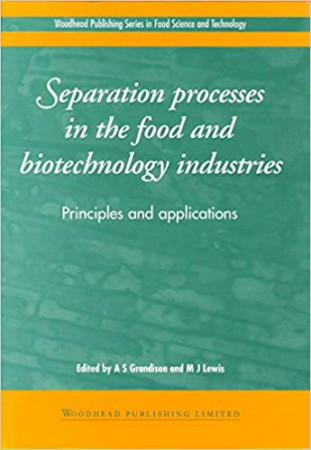SEPARATION PROCESSES IN THE FOOD AND BIOTECHNOLOGY INDUSTRIES Principles and Applications
Keterangan Bibliografi
| Pengarang | : Grandison, A.S. (editor) |
| Pengarang 2 | : |
| Kontributor | : Lewis, M.J. (editor) |
| Penerbit | : Woodhead Publishing Limited |
| Kota terbit | : Abington, Cambridge |
| Tahun terbit | : 1996 |
| ISBN | : I 85573 287 4 |
| Subyek | : Food Biotechnology - Principles - Applications |
| Klasifikasi | : 664.024 Gra s |
| Bahasa | : English |
| Edisi | : |
| Halaman | : 296 hlm.: ilus. |
Jenis Koleksi Pustaka
E-Book
Kategori Pustaka
Tidak ada kategori
Abstraksi
SEPARATION PROCESSES IN THE FOOD AND BIOTECHNOLOGY INDUSTRIES Principles and Applications concentrates on the more recent methods and techniques for separating food components and products of the biotechnology industry. Each chapter deals with a specific type or area of application and includes information on the basic principles, industrial equipment available, commercial applications and an overview of current research and development. The introductory chapter gives a brief overview of food composition and properties, and some of the heat and mass transfer considerations in batch and continuous processes. A summary is provided of the more conventional separation techniques such as screening, filtration and centrifugation, and techniques for removing water, such as evaporation, freezeconcentration and dehydration. Chapter 2 deals with the use of supercritical fluids for extraction processes, with special reference to carbon dioxide. Chapter 3 deals with pressureactivated membrane techniques, and covers the general principles, reviews the applications of reverse osmosis, and serves as an introduction to Chapters 4 and 5, which deal specifically with the principles and applications of ultrafiltration and microfiltration respectively. The separation and recovery of charged particles by ion exchange and electrodialysis is covered in Chapter 6. Chapter 7 discusses innovative separation processes, and reviews some of the methods being actively investigated, some of which are now coming into industrial practice. Much of the emphasis in these chapters is on the separation and recovery of proteins and biologically active ingredients. Chapter 8 is specifically on the methods available for fractionating fat, and covers the upsurge in interest and recent developments in this area. The book concludes with a chapter on solids separation processes, with special reference to particulates. The physical properties which influence the separation are reviewed, together with sieving, screening and air classification.
Inventaris
| # | Inventaris | Dapat dipinjam | Status Ada |
| 1 | 9259/P1/2020.c1 | Ya | |
| 2 | 9260/P1/2020.c2 | Ya | |
| 3 | 9261/P1/2020.c3 | Ya | |
| 4 | 9262/P1/2020.c4 | Ya | |
| 5 | 9263/P1/2020.c5 | Ya | |
| 6 | 9264/P1/2020.c6 | Ya |
